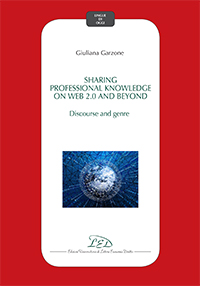
Giuliana Garzone
SHARING PROFESSIONAL KNOWLEDGE
ON WEB 2.0 AND BEYOND
Discours and genre
ISBN 978-88-7916-927-1 - 15 x 22 cm - 2019 - pp. 132
![]() Copia cartacea / Paperback copy € 23,00 (-15%)
Copia cartacea / Paperback copy € 23,00 (-15%) ![]() € 19,55
€ 19,55
 € 13,99
€ 13,99
Giuliana Garzone is Full Professor of English, Linguistics and Translation at IULM University, Milan, where she co-ordinates the Master’s Progamme in Specialised Translation and Conference Interpreting. She formerly taught at Milan State University where she directed the PhD Programme in Linguistic, Literary and Intercultural Studies. Her research interests are mainly in ESP, which she has explored in a discourse analytical perspective, integrating it with corpus linguistics, and in Translation and Interpreting Studies. She has co-ordinated several research projects and published extensively on legal, scientific and business discourse as well as on translation and interpreting. She is co-editor-in-chief (with Paola Catenaccio) of the journal Lingue Culture Mediazioni / Languages Cultures Mediation. Her most recent publications include: “New Biomedical Practices and Discourses: Focus on Surrogacy” (2019); “The Interpreter Mediated Police Interview as Argumentative Discourse in Context: A Case-study” (2017), published in the volume Argumentation across Communities of Practice she edited with C. Ilie, and the volume Le traduzioni come fuzzy set. Percorsi teorici e applicativi (2015).

Introduction
1. Why “Web 2.0 and beyond”?
2. The linguistic perspective
1. Investigating Genres on the Web: Methodological Issues
1. Introduction
2. The linguistic perspective
3. Properties to be incorporatedin the analysis of Web-mediated genres
3.1. Extension in participation framework – 3.2. Multimodality – 3.3. Hypertextuality/hypermediality – 3.3.1. Co-articulation and interactivity – 3.3.2. Multiple reading modes – 3.3.3. Intertextuality – 3.3.4. Granularity
4. Generic integrity
5. Conclusion
2. The Law Blog: Issues of Generic Integrity
1. Introduction
1.1. Extension in participation framework
2. Aim, scope and method
2.1. Methodological issues – 2.2. Compiling a Webderived corpus: the case of blogs – 2.3. Corpus description
3. Blog profiles
3.1. Recurrent lexicon – 3.2. Internal constitution
4. Analysis: self-mentions and other individualistic elements
4.1. Pronominal reference – 4.2. Self-mention and theme – 4.3. Lexical verbs with first-person singular pronouns
5. Conclusion
3. Sharing Knowledgeon Social Networking Sites: Professional Groups on Facebook and LinkedIn
1. Aim and method
2. Professional groups on SNSs
2.1. Professional networking and online communities
3. Facebook groups
3.1. The FB profile and identity construction
4. LinkedIn groups
4.1. The LI profile – 4.2. Professional groups on LI
5. Conclusion
4. Legal Professionals’ Groups on SNSs: Focus on LinkedIn
1. Introduction
2. Materials and method
2.1. Corpus description – 2.2. Method
3. Conversations on LI groups
3.1. Posts: discursive aspects – 3.2. Comments
4. Final remarks
5. Social Media for HR Recruitment: Job Advertisements on LinkedIn
1. Introduction: LinkedIn as the professional social networking site
2. Materials and method
3. The job advertisement as a genre
3.1. Job ads on online recruitment platforms – 3.2. Job ads on LinkedIn – 3.3. Moves in LinkedIn job ads
4. Final remarks